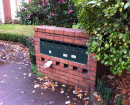Wooreen Avenue of Honour
Leongatha-Yarragon Road WOORARRA EAST, South Gippsland Shire
-
Add to tour
You must log in to do that.
-
Share
-
Shortlist place
You must log in to do that.
- Download report



Statement of Significance
What is Significant?
The Wooreen Avenue of Honour, established in July 1918, at Leongatha-Yarragon Road, Wooreen.
Why is it Significant?
he Wooreen Avenue of Honour is of local historic, social and aesthetic significance to the district of Wooreen.
Historically, it is important as one of a series of similar memorial avenues that were established throughout the Shire following the planting of the Leongatha Memorial Avenue of Honour earlier in the same year, and expresses the significant effect that the First World War had upon small rural communities. (AHC criteria - A.4 and D.2) Socially, the Avenue is important as a memorial to local residents who served in World War 1, and together with the former Wooreen State School is an integral part of the identity of the local area.
(AHC criterion - G.1) Aesthetically, the now mature avenue enhances the Leongatha-Yarragon Road. (AHC criterion - E.1)
-
-
Wooreen Avenue of Honour - Physical Description 1
The Wooreen Avenue of Honour is situated within a 100-150m long section of the Leongatha- Yarragon Road, near the former Wooreen Primary School at the corner of Wooreen-Mirboo North. The avenue was planted with 35 trees, on 29th July 1918, to commemorate those district servicemen who fought in the First World War.
Wooreen Avenue of Honour - Physical Description 2
Style
Honour Avenue
Wooreen Avenue of Honour - Historical Australian Themes
Thematic Context
Government + Community Institutions
Sub-Themes
Military Defence
Veterans Description for Public
Wooreen Avenue of Honour - Veterans Description for Public
The Wooreen Avenue of Honour was planted on July 29th 1918 by local residents to commemorate the First World War. The avenue is situated within a 100-150 metre section of the Leongatha- Yarragon Road, near the former Wooreen Primary School at the corner of Wooreen-Mirboo North. On 16th July 1918, an article in the Great Southern Star reported that the intention was to plant an avenue of trees "on similar conditions to that at Leongatha, as a lasting memory to the young men who enlisted from the district, and those who had resided at Wooreen prior to the outbreak of the war."
The construction of the avenue happened at about the same time as the planting of similar memorial avenues within the then Shire of Woorayl at Berry's Creek, Koorooman, Meeniyan and Nerrena. A total of thirty-five trees were planted and students from the primary school maintained the avenue for many years. There are also a number of juvenile trees that appear to have grown from the seed of the original trees. On 29th July 2008, a restoration of the avenue was completed to mark the 90th anniversary of the avenue and a small rock and plaque unveiled to record its history.
In Australia, commemorative trees have been planted in public spaces since the late nineteenth century. Arbor Days were held regularly in most Victorian State Schools during the late 1800s and early 1900s, and numerous trees were planted in parks in Melbourne and throughout Victoria to mark the visits of important and famous people.
This tradition of commemorative planting was continued in 1901 when at the end of the Boer War trees were often planted for each soldier of the district who was killed in South Africa. These plantings, however, rarely consisted of more than two or three trees in each town.
During and after the First World War avenues of honour consisting of trees lining significant streets became a popular form of commemoration. They represented a new egalitarian approach to the commemoration of soldiers where rank was not a consideration: each tree symbolises a person.
Avenues of honour are a uniquely Australian phenomenon. Australians, and in particular Victorians, embraced the idea of planting them more enthusiastically than any other country in the world. Dating from May 1916, the Eurack Avenue of Honour is the earliest known avenue of honour to be planted in Victoria.
By the time of the Second World War avenues of honour had declined in popularity as a means of commemoration. Today it is estimated that over 300 avenues of honour have been planted in Victoria to commemorate service personnel since 1901.
Heritage Study and Grading
South Gippsland - South Gippsland Heritage Study
Author: David Helms with Trevor Westmore
Year: 2004
Grading:
-
-
-
-
-
WOORARRA HALL (FORMER)
 South Gippsland Shire
South Gippsland Shire -
WOOREEN AVENUE OF HONOUR
 South Gippsland Shire
South Gippsland Shire -
WOOREEN STATE SCHOOL NO. 3723 (FORMER)
 South Gippsland Shire
South Gippsland Shire
-
1 Brockenshire Street
 Yarra City
Yarra City -
1 Bundara Street
 Yarra City
Yarra City -
1 Forster Street
 Hobsons Bay City
Hobsons Bay City
-
-











